Analysis of IFRS Fair Value Accounting Techniques and Standards
VerifiedAdded on 2023/01/06
|6
|1056
|21
Report
AI Summary
This report provides an analysis of IFRS fair value accounting techniques, focusing on the challenges encountered, particularly during the 2008-09 financial crisis. It discusses how traditional cost systems were not linked to the market and various assets of monetary institutes were linked to the market. The report examines the criticisms of fair value accounting and its impact on financial statements, highlighting issues that led to economic crises. Furthermore, it assesses the enhancements made to IFRS fair value standards between 2009 and 2020, including the collaboration between FASB and IASB and changes in valuation premise concepts, such as 'in use' and 'in exchange', and the concept of higher and optimal usage. The report references online sources for its findings.
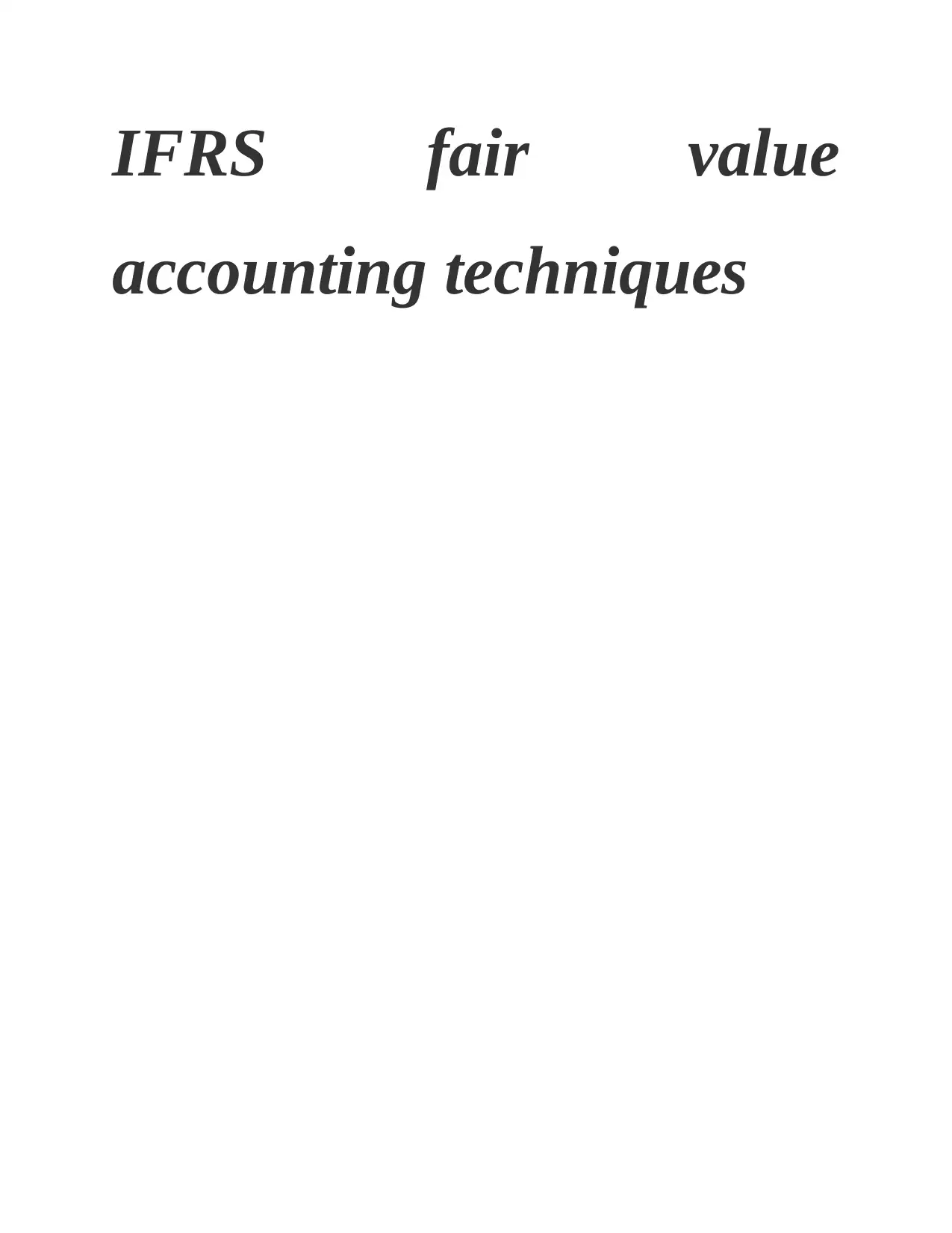
IFRS fair value
accounting techniques
accounting techniques
Paraphrase This Document
Need a fresh take? Get an instant paraphrase of this document with our AI Paraphraser
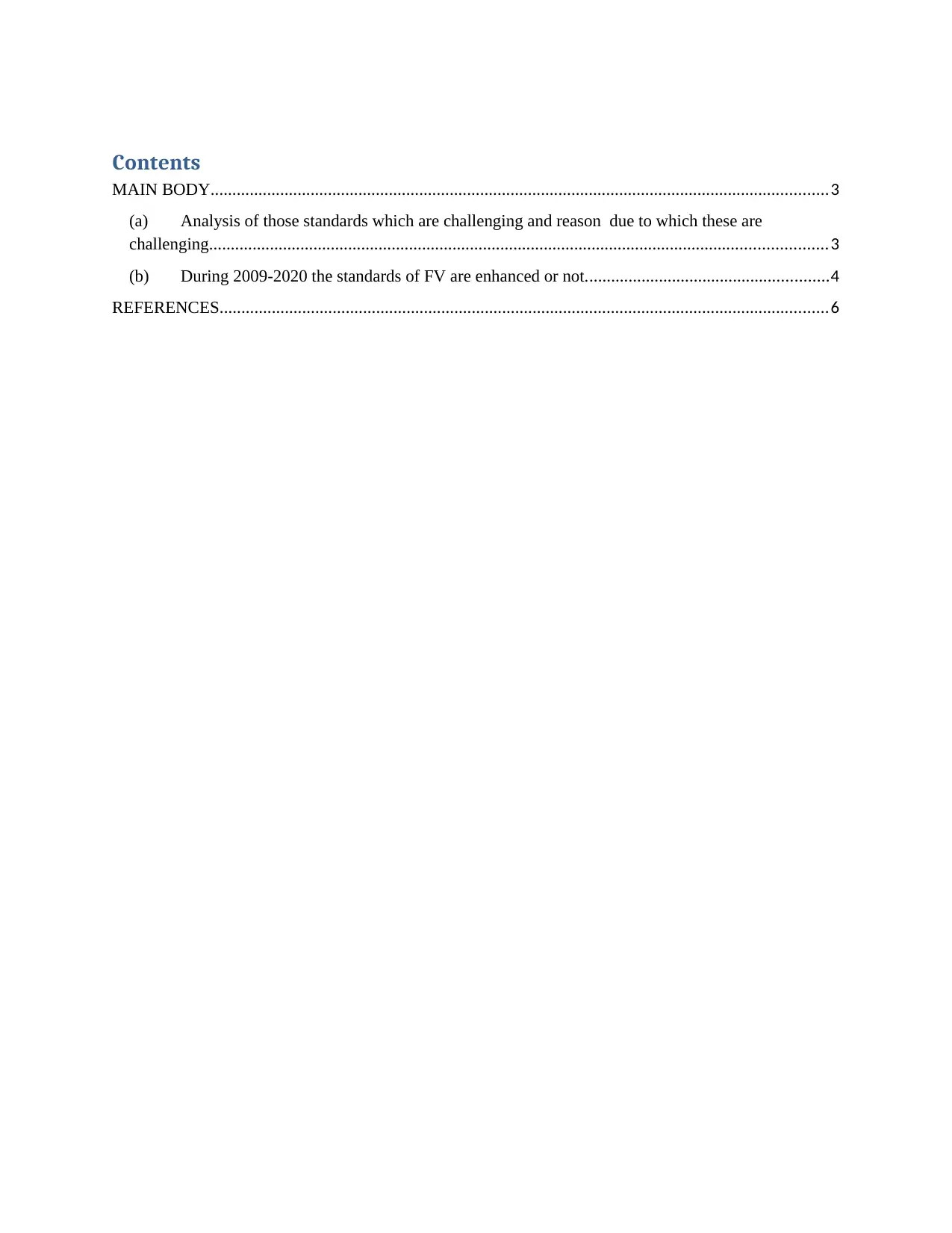
Contents
MAIN BODY..............................................................................................................................................3
(a) Analysis of those standards which are challenging and reason due to which these are
challenging..............................................................................................................................................3
(b) During 2009-2020 the standards of FV are enhanced or not........................................................4
REFERENCES............................................................................................................................................6
MAIN BODY..............................................................................................................................................3
(a) Analysis of those standards which are challenging and reason due to which these are
challenging..............................................................................................................................................3
(b) During 2009-2020 the standards of FV are enhanced or not........................................................4
REFERENCES............................................................................................................................................6
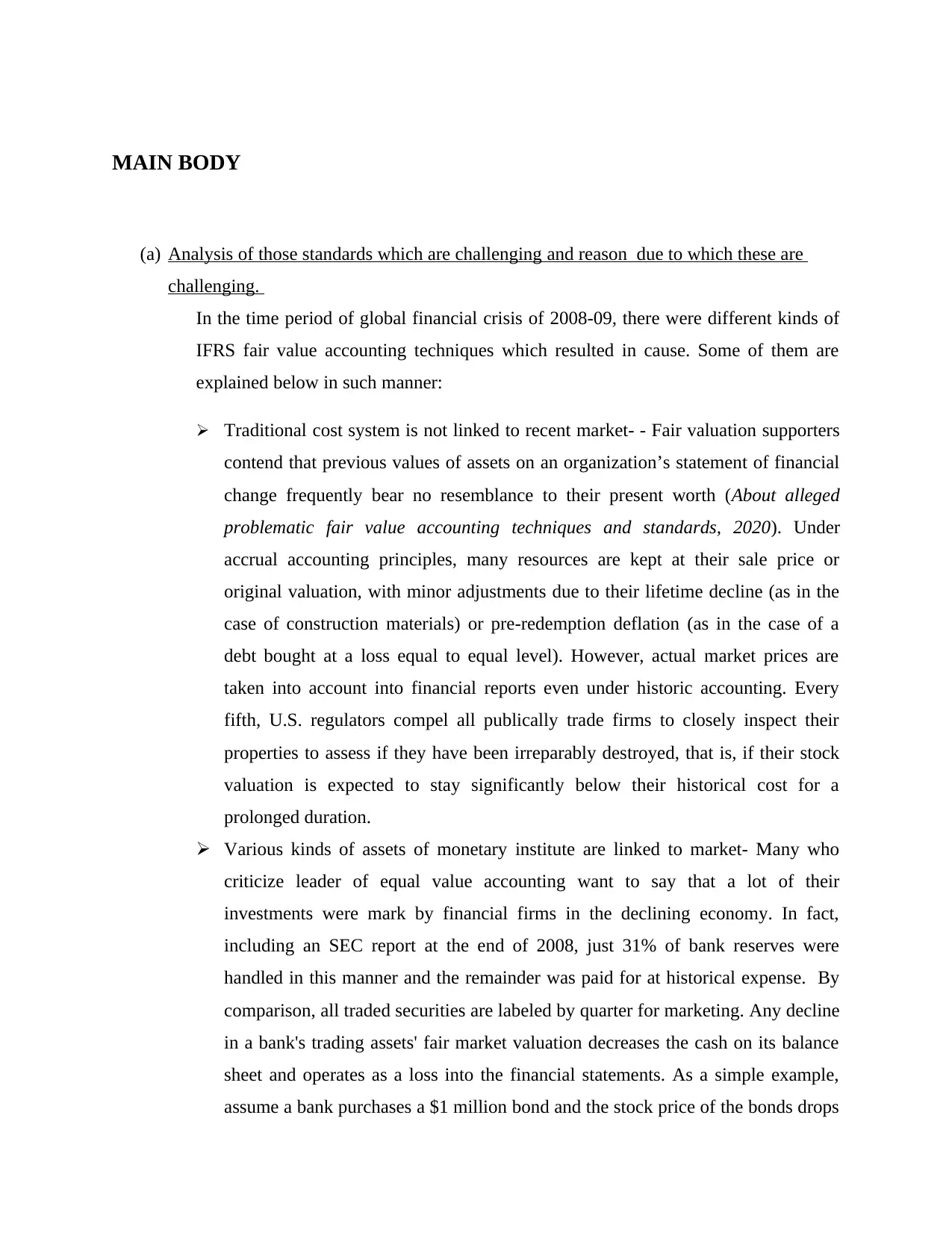
MAIN BODY
(a) Analysis of those standards which are challenging and reason due to which these are
challenging.
In the time period of global financial crisis of 2008-09, there were different kinds of
IFRS fair value accounting techniques which resulted in cause. Some of them are
explained below in such manner:
Traditional cost system is not linked to recent market- - Fair valuation supporters
contend that previous values of assets on an organization’s statement of financial
change frequently bear no resemblance to their present worth (About alleged
problematic fair value accounting techniques and standards, 2020). Under
accrual accounting principles, many resources are kept at their sale price or
original valuation, with minor adjustments due to their lifetime decline (as in the
case of construction materials) or pre-redemption deflation (as in the case of a
debt bought at a loss equal to equal level). However, actual market prices are
taken into account into financial reports even under historic accounting. Every
fifth, U.S. regulators compel all publically trade firms to closely inspect their
properties to assess if they have been irreparably destroyed, that is, if their stock
valuation is expected to stay significantly below their historical cost for a
prolonged duration.
Various kinds of assets of monetary institute are linked to market- Many who
criticize leader of equal value accounting want to say that a lot of their
investments were mark by financial firms in the declining economy. In fact,
including an SEC report at the end of 2008, just 31% of bank reserves were
handled in this manner and the remainder was paid for at historical expense. By
comparison, all traded securities are labeled by quarter for marketing. Any decline
in a bank's trading assets' fair market valuation decreases the cash on its balance
sheet and operates as a loss into the financial statements. As a simple example,
assume a bank purchases a $1 million bond and the stock price of the bonds drops
(a) Analysis of those standards which are challenging and reason due to which these are
challenging.
In the time period of global financial crisis of 2008-09, there were different kinds of
IFRS fair value accounting techniques which resulted in cause. Some of them are
explained below in such manner:
Traditional cost system is not linked to recent market- - Fair valuation supporters
contend that previous values of assets on an organization’s statement of financial
change frequently bear no resemblance to their present worth (About alleged
problematic fair value accounting techniques and standards, 2020). Under
accrual accounting principles, many resources are kept at their sale price or
original valuation, with minor adjustments due to their lifetime decline (as in the
case of construction materials) or pre-redemption deflation (as in the case of a
debt bought at a loss equal to equal level). However, actual market prices are
taken into account into financial reports even under historic accounting. Every
fifth, U.S. regulators compel all publically trade firms to closely inspect their
properties to assess if they have been irreparably destroyed, that is, if their stock
valuation is expected to stay significantly below their historical cost for a
prolonged duration.
Various kinds of assets of monetary institute are linked to market- Many who
criticize leader of equal value accounting want to say that a lot of their
investments were mark by financial firms in the declining economy. In fact,
including an SEC report at the end of 2008, just 31% of bank reserves were
handled in this manner and the remainder was paid for at historical expense. By
comparison, all traded securities are labeled by quarter for marketing. Any decline
in a bank's trading assets' fair market valuation decreases the cash on its balance
sheet and operates as a loss into the financial statements. As a simple example,
assume a bank purchases a $1 million bond and the stock price of the bonds drops
⊘ This is a preview!⊘
Do you want full access?
Subscribe today to unlock all pages.

Trusted by 1+ million students worldwide
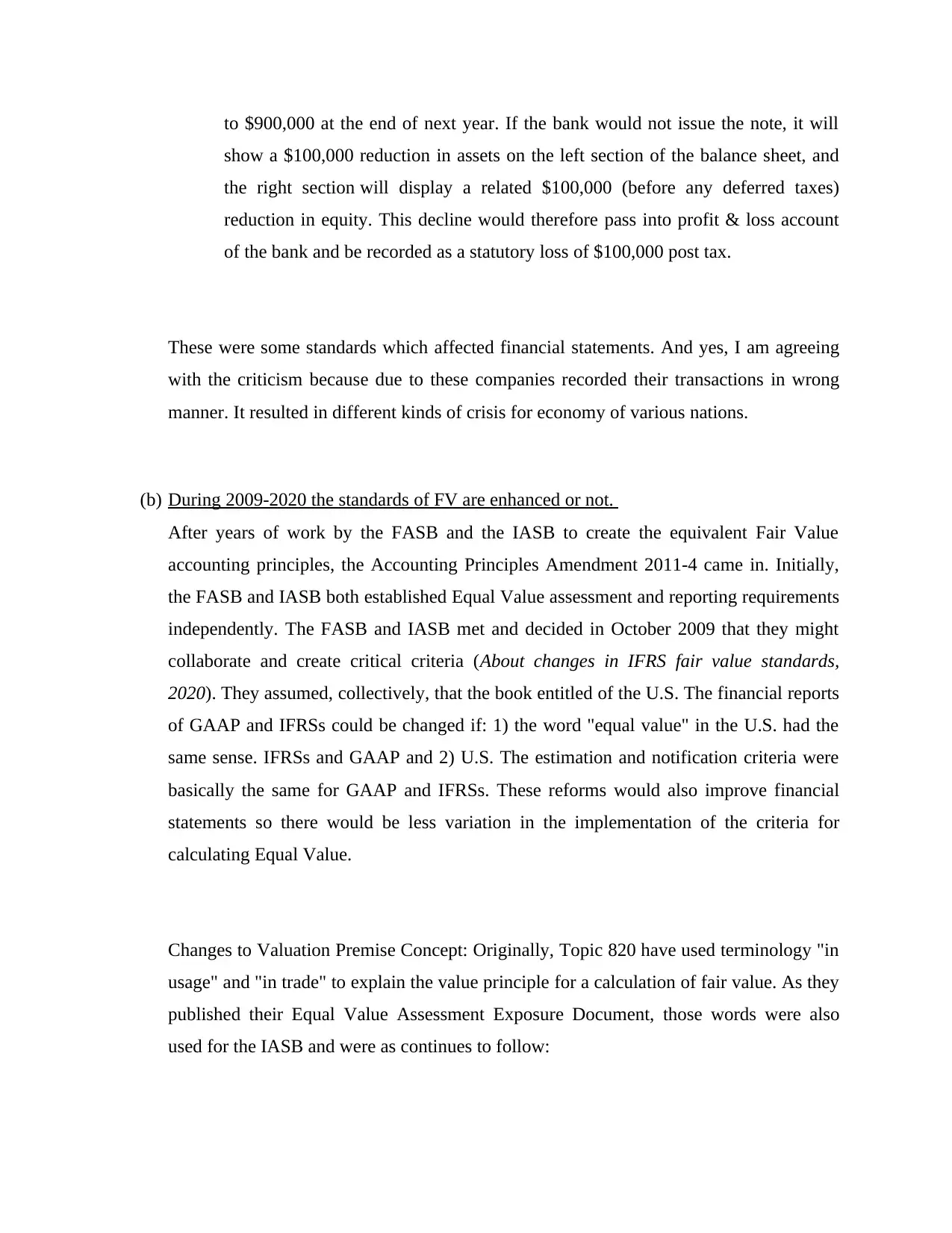
to $900,000 at the end of next year. If the bank would not issue the note, it will
show a $100,000 reduction in assets on the left section of the balance sheet, and
the right section will display a related $100,000 (before any deferred taxes)
reduction in equity. This decline would therefore pass into profit & loss account
of the bank and be recorded as a statutory loss of $100,000 post tax.
These were some standards which affected financial statements. And yes, I am agreeing
with the criticism because due to these companies recorded their transactions in wrong
manner. It resulted in different kinds of crisis for economy of various nations.
(b) During 2009-2020 the standards of FV are enhanced or not.
After years of work by the FASB and the IASB to create the equivalent Fair Value
accounting principles, the Accounting Principles Amendment 2011-4 came in. Initially,
the FASB and IASB both established Equal Value assessment and reporting requirements
independently. The FASB and IASB met and decided in October 2009 that they might
collaborate and create critical criteria (About changes in IFRS fair value standards,
2020). They assumed, collectively, that the book entitled of the U.S. The financial reports
of GAAP and IFRSs could be changed if: 1) the word "equal value" in the U.S. had the
same sense. IFRSs and GAAP and 2) U.S. The estimation and notification criteria were
basically the same for GAAP and IFRSs. These reforms would also improve financial
statements so there would be less variation in the implementation of the criteria for
calculating Equal Value.
Changes to Valuation Premise Concept: Originally, Topic 820 have used terminology "in
usage" and "in trade" to explain the value principle for a calculation of fair value. As they
published their Equal Value Assessment Exposure Document, those words were also
used for the IASB and were as continues to follow:
show a $100,000 reduction in assets on the left section of the balance sheet, and
the right section will display a related $100,000 (before any deferred taxes)
reduction in equity. This decline would therefore pass into profit & loss account
of the bank and be recorded as a statutory loss of $100,000 post tax.
These were some standards which affected financial statements. And yes, I am agreeing
with the criticism because due to these companies recorded their transactions in wrong
manner. It resulted in different kinds of crisis for economy of various nations.
(b) During 2009-2020 the standards of FV are enhanced or not.
After years of work by the FASB and the IASB to create the equivalent Fair Value
accounting principles, the Accounting Principles Amendment 2011-4 came in. Initially,
the FASB and IASB both established Equal Value assessment and reporting requirements
independently. The FASB and IASB met and decided in October 2009 that they might
collaborate and create critical criteria (About changes in IFRS fair value standards,
2020). They assumed, collectively, that the book entitled of the U.S. The financial reports
of GAAP and IFRSs could be changed if: 1) the word "equal value" in the U.S. had the
same sense. IFRSs and GAAP and 2) U.S. The estimation and notification criteria were
basically the same for GAAP and IFRSs. These reforms would also improve financial
statements so there would be less variation in the implementation of the criteria for
calculating Equal Value.
Changes to Valuation Premise Concept: Originally, Topic 820 have used terminology "in
usage" and "in trade" to explain the value principle for a calculation of fair value. As they
published their Equal Value Assessment Exposure Document, those words were also
used for the IASB and were as continues to follow:
Paraphrase This Document
Need a fresh take? Get an instant paraphrase of this document with our AI Paraphraser
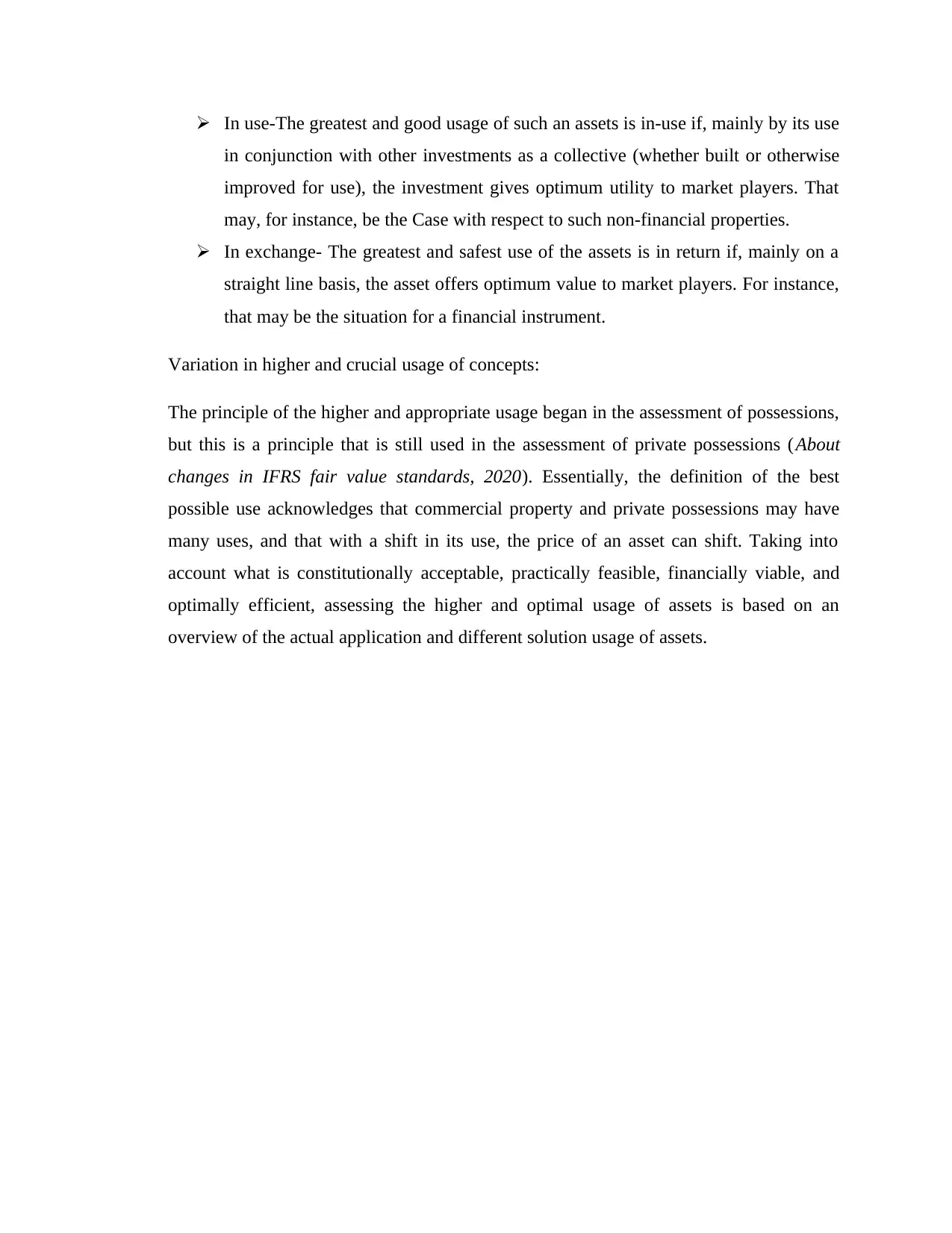
In use-The greatest and good usage of such an assets is in-use if, mainly by its use
in conjunction with other investments as a collective (whether built or otherwise
improved for use), the investment gives optimum utility to market players. That
may, for instance, be the Case with respect to such non-financial properties.
In exchange- The greatest and safest use of the assets is in return if, mainly on a
straight line basis, the asset offers optimum value to market players. For instance,
that may be the situation for a financial instrument.
Variation in higher and crucial usage of concepts:
The principle of the higher and appropriate usage began in the assessment of possessions,
but this is a principle that is still used in the assessment of private possessions (About
changes in IFRS fair value standards, 2020). Essentially, the definition of the best
possible use acknowledges that commercial property and private possessions may have
many uses, and that with a shift in its use, the price of an asset can shift. Taking into
account what is constitutionally acceptable, practically feasible, financially viable, and
optimally efficient, assessing the higher and optimal usage of assets is based on an
overview of the actual application and different solution usage of assets.
in conjunction with other investments as a collective (whether built or otherwise
improved for use), the investment gives optimum utility to market players. That
may, for instance, be the Case with respect to such non-financial properties.
In exchange- The greatest and safest use of the assets is in return if, mainly on a
straight line basis, the asset offers optimum value to market players. For instance,
that may be the situation for a financial instrument.
Variation in higher and crucial usage of concepts:
The principle of the higher and appropriate usage began in the assessment of possessions,
but this is a principle that is still used in the assessment of private possessions (About
changes in IFRS fair value standards, 2020). Essentially, the definition of the best
possible use acknowledges that commercial property and private possessions may have
many uses, and that with a shift in its use, the price of an asset can shift. Taking into
account what is constitutionally acceptable, practically feasible, financially viable, and
optimally efficient, assessing the higher and optimal usage of assets is based on an
overview of the actual application and different solution usage of assets.
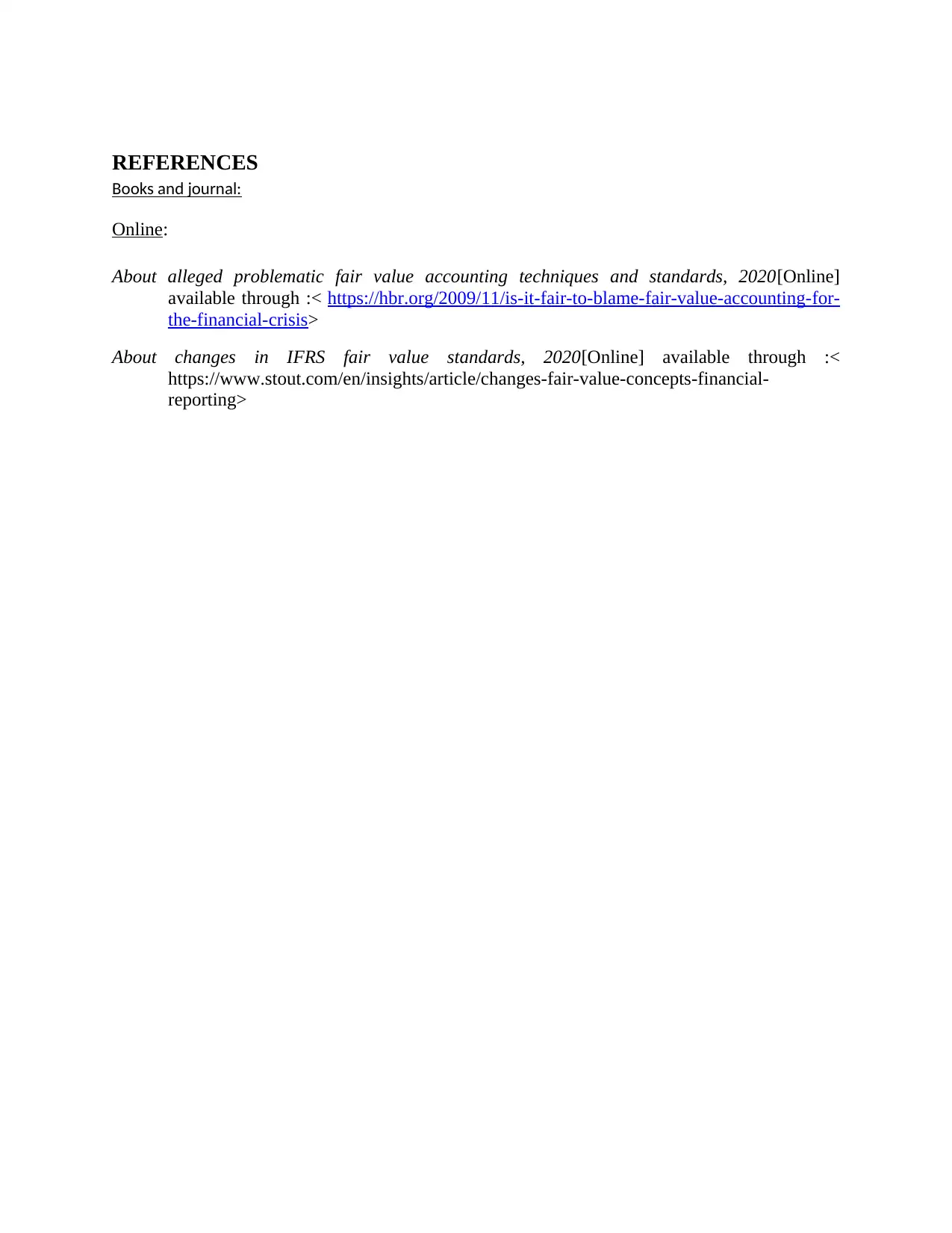
REFERENCES
Books and journal:
Online:
About alleged problematic fair value accounting techniques and standards, 2020[Online]
available through :< https://hbr.org/2009/11/is-it-fair-to-blame-fair-value-accounting-for-
the-financial-crisis>
About changes in IFRS fair value standards, 2020[Online] available through :<
https://www.stout.com/en/insights/article/changes-fair-value-concepts-financial-
reporting>
Books and journal:
Online:
About alleged problematic fair value accounting techniques and standards, 2020[Online]
available through :< https://hbr.org/2009/11/is-it-fair-to-blame-fair-value-accounting-for-
the-financial-crisis>
About changes in IFRS fair value standards, 2020[Online] available through :<
https://www.stout.com/en/insights/article/changes-fair-value-concepts-financial-
reporting>
⊘ This is a preview!⊘
Do you want full access?
Subscribe today to unlock all pages.

Trusted by 1+ million students worldwide
1 out of 6
Related Documents
Your All-in-One AI-Powered Toolkit for Academic Success.
+13062052269
info@desklib.com
Available 24*7 on WhatsApp / Email
![[object Object]](/_next/static/media/star-bottom.7253800d.svg)
Unlock your academic potential
Copyright © 2020–2025 A2Z Services. All Rights Reserved. Developed and managed by ZUCOL.





